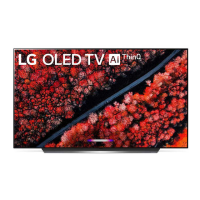
Do you have a question about the LG OLED55/65C9PUA and is the answer not in the manual?
| Display Type | OLED |
|---|---|
| Refresh Rate | 120Hz |
| Processor | α9 Gen 2 Intelligent Processor |
| Operating System | webOS |
| HDMI Ports | 4 |
| USB Ports | 3 |
| Ethernet | Yes |
| Bluetooth | Yes |
| Audio Output | 40W (2.2 Channel) |
| Dolby Atmos | Yes |
| eARC | Yes |
| Variable Refresh Rate (VRR) | Yes |
| Auto Low Latency Mode (ALLM) | Yes |
| VESA Mount | 300 x 200 mm |
| Screen Size | 55" / 65" |
| Resolution | 3840 x 2160 |
| HDR Support | HDR10, Dolby Vision, HLG |
| Smart Features | Google Assistant, Amazon Alexa |
| Wi-Fi | 802.11ac |
General advice and precautions for safe servicing and handling of electronic equipment.
Procedure to measure AC leakage current to ensure safety before returning the unit.
Basic safety rules to follow before, during, and after servicing electronic devices.
Guidelines for handling and protecting sensitive electronic components from static discharge.
Best practices for soldering, including tool usage, temperature, and techniques.
Defines the scope and models to which these specifications apply.
Outlines the environmental and power conditions under which tests are performed.
Describes the procedures and standards used for testing product performance and compliance.
Provides overall technical specifications for the device, including inputs and outputs.
Lists supported resolutions, frequencies, and pixel clocks for HDMI PC and DTV inputs.
Instructions for updating the TV's software using a USB flash drive.
Steps for performing Network Software Update to get the latest firmware.
Overview of the main integrated circuit and its primary connections.
Shows the connection and signal flow for the TV tuner module.
Illustrates the paths for video and audio signals entering and leaving the main IC.
Details the HDMI 2.1 interface, including supported versions and connections.
Depicts the block diagram for USB, Wi-Fi, M-Remote, and UART interfaces.
Shows the I2C communication map and device addresses for various components.
Troubleshooting procedures for issues related to video display and image quality.
Diagnostic steps for problems concerning the TV's power supply and operation.
Troubleshooting guide for issues related to sound output and audio playback.
Steps to diagnose and fix problems with the TV's various functions and features.
Procedures for identifying and resolving circuit noise or mechanical noise issues.
Guidance on diagnosing and handling issues related to the TV's physical casing or external appearance.
